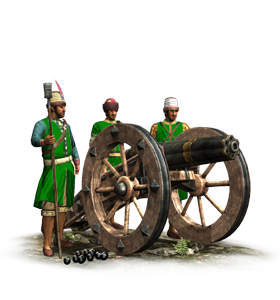Difference between revisions of "Organ Gun (ETW Unit)"
(→Details) |
Shackleton (talk | contribs) |
||
| Line 1: | Line 1: | ||
| − | {{Unit|image=[[ | + | {{TW Unit|image=[[Image:Organ gun.png]] |
| + | |Class=Fixed Artillery | ||
| + | |Unit Size=24 men | ||
| + | |Weaponry=Organ gun | ||
| + | |Region=Global | ||
| + | |Recruitment Cost=1330 | ||
| + | |Upkeep Cost=330 | ||
| + | |Building Requirements=Cannon Foundry | ||
| + | |Tech Requirements=None | ||
| + | |Attributes=<li>Can Hide in Woodland</li> | ||
| + | }} | ||
| + | |||
[[Image:Organ_gun_thumbnail.png]]Thanks to its multiple barrels, an organ gun can fire devastating volleys all on its own. | [[Image:Organ_gun_thumbnail.png]]Thanks to its multiple barrels, an organ gun can fire devastating volleys all on its own. | ||
Revision as of 14:19, 6 January 2013
 Thanks to its multiple barrels, an organ gun can fire devastating volleys all on its own.
Thanks to its multiple barrels, an organ gun can fire devastating volleys all on its own.
Overview
An organ gun has several barrels that are fired, almost simultaneously, when the gunner applies the match. In theory, each barrel could be loaded with a different kind of projectile, although given the different ranges of, say, shot and canister, this would be wasteful. Only a suicidal or slightly mad artilleryman would use explosive shells. There is a good chance that the first shell would have exploded in its barrel before the last is prepared.
There has always been a tendency to make artillery pieces with more than one barrel. The great Leonardo da Vinci was among many to design a ribauldequin, or volley gun. As so often with artillery, the Ottoman Turks were ahead of European gunmakers in their work. They also persisted with producing organ guns after other nations had abandoned them. They also experimented with cannons of differing calibres, where a central barrel would be surrounded by small bore tubes cast into the main cannon wall. The French also flirted with a design for a triple-barrelled cannon early in the 18th Century, but it was heavy and offered no real advantages over three ordinary guns of the same calibre.
Details
Unique to the Ottoman Empire as downloadable content, organ guns bring a devastating amount of artillery firepower to the battlefield. These weapons are especially useful for taking out large groups of infantry: they fire what amounts to a very large amount of long-range grape shot in a straight line. However, they are very expensive to train and maintain and are also immobile on the battlefield. This means that one should only use them if troops are available to defend them, and if the costs incurred can be afforded.
